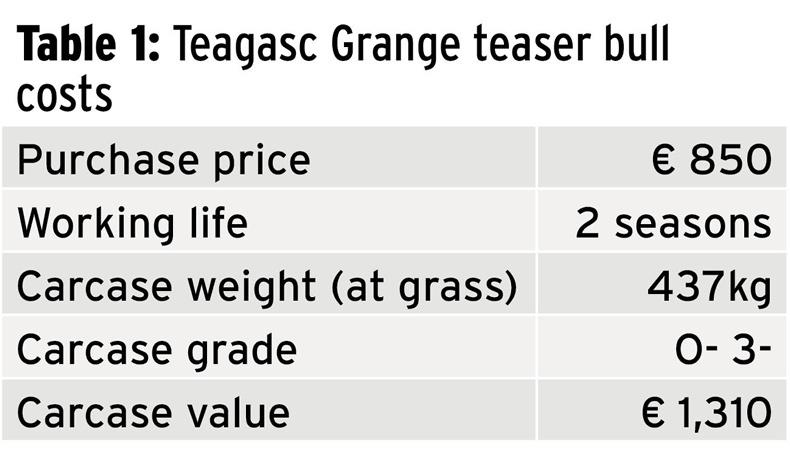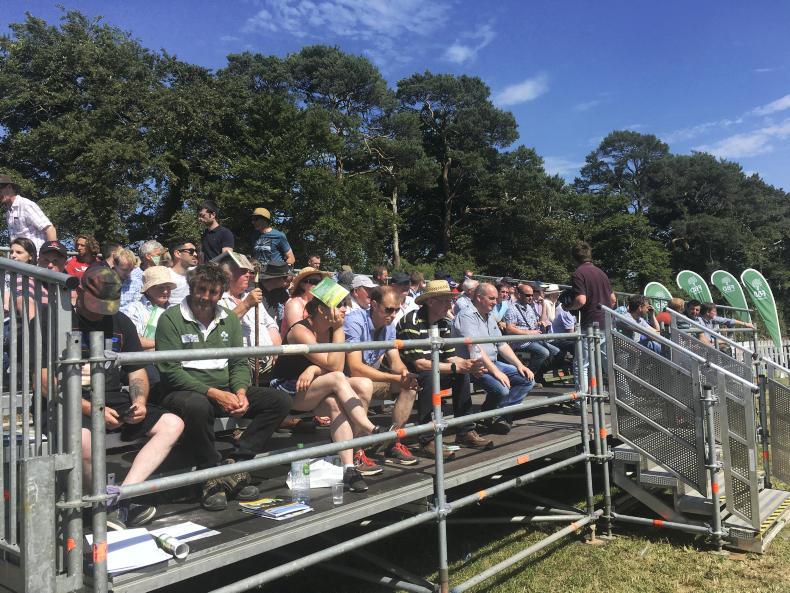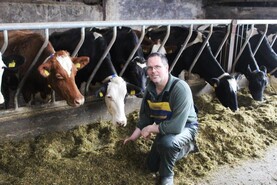Should more AI be used in the suckler herd? This was one of the key issues discussed at the livestock demo and Gary Fisher from Teagasc argued that irrespective of small herd size and part-time operators, more AI should be used.
There are currently only 24% of calves born in the suckler herd from AI sires. If we look at dairying, that figure is 60%.
“It’s very hard for smaller herds to justify a very large expenditure on a top of the range pedigree bull. If a farmer pays €3,000 for a bull that produces 20 calves annually over four years it costs €45/calf when maintenance costs and salvage costs are included. That rises to €57/calf if the bull costs €4,000. Using AI provides smaller herds with the ability to match sire to different cows depending on the attributes of individual cows.
“This choice comes at a reasonable cost. The current ICBF active bull list for the top 30 replacement bulls have an average replacement index of €158, a high reliability figure of 73%, a calving difficulty figure of 4.54% at an average price of €16.26/straw.”
Key factors to achieving a successful AI programme are:
Cows are cycling before the breeding season starts.Adequate nutrition in the post-calving period.Good heat detection rates.Good handling facilities.Good heat detection rates can be achieved by using some simple aids like tail paint, scratch cards and kamars. These are all being used in beef herds to good effect. A vasectomised bull is also an excellent way of picking up cows in heat. A chin ball can be fitted to make sure no cows are missed.
A number of farmers questioned the labour associated with it and commented that it just wasn’t a runner in a part time system.

Choosing replacement females
Chris Daly from the ICBF gave a presentation on selecting tomorrow’s suckler cows and what needs to be factored into the selection process.
One of the first questions that came up was whether it was worthwhile for a small operator to be breeding their own replacements. There are pros and cons to both systems. The simplicity of selling everything needs to be weighed up against the health implications of buying stock.
The second question was “where are you starting from?” If the average replacement index of your herd is very low, it may be beneficial to buy in some superior stock to breed replacements from.
Using the €uro-Star index as a breeding tool
Chris also outlined how best to use the replacement index as a tool when planning the breeding programme for your herd.
The first decision to make is on your production system – export weanlings? Bull beef? Breeding replacement heifers? Once this is decided you can drill down into the figures and select what is appropriate to your herd. Identify where your herd is weak and try to correct this.
The HerdPlus reports will give you a herd average and can then look closer at individual sub-indexes like carcase weight, milk and calving interval.
The sires that are used on your herd should be genetically superior to the animals that are already in your herd. This goes for stock bulls as well as AI. You won’t make progress if sire indexes are not higher every year. In selecting replacement heifers, the following four steps should be followed:
Visual assessment – are females docile and functional?Weight gain – are females meeting weight targets?Genotyping – do animals have genomic indexes?€uro-Star indexes – do females have high, balanced replacement indexes?Is the current €uro-Star index system working and are we headed in the right direction?
Some interesting data was presented on the direction that the national herd is going. There are some commentators saying that the quality and weight of suckler-bred cattle is going down as the industry pursues more milk, fertility and maternal traits.

Table 3 demonstrates that this isn’t the case and that in fact the terminal traits of steers are increasing in carcase weight with a reduced finishing time when compared with 2014 levels.
During that period, carcase weight has increased by 6kg and finishing time has reduced by six weeks, which is a big cost saving in a finishing system.

Table 2 shows maternal traits are also moving in the right direction with an extra 0.7 calf/cow /year being weaned in BDGP herds in 2017 compared to 2014. Calving interval has reduced by 14 days and heifers calving at 24 months has increased by 9%.
Read more
Sheep trends: supply and demand finely balanced
Should more AI be used in the suckler herd? This was one of the key issues discussed at the livestock demo and Gary Fisher from Teagasc argued that irrespective of small herd size and part-time operators, more AI should be used.
There are currently only 24% of calves born in the suckler herd from AI sires. If we look at dairying, that figure is 60%.
“It’s very hard for smaller herds to justify a very large expenditure on a top of the range pedigree bull. If a farmer pays €3,000 for a bull that produces 20 calves annually over four years it costs €45/calf when maintenance costs and salvage costs are included. That rises to €57/calf if the bull costs €4,000. Using AI provides smaller herds with the ability to match sire to different cows depending on the attributes of individual cows.
“This choice comes at a reasonable cost. The current ICBF active bull list for the top 30 replacement bulls have an average replacement index of €158, a high reliability figure of 73%, a calving difficulty figure of 4.54% at an average price of €16.26/straw.”
Key factors to achieving a successful AI programme are:
Cows are cycling before the breeding season starts.Adequate nutrition in the post-calving period.Good heat detection rates.Good handling facilities.Good heat detection rates can be achieved by using some simple aids like tail paint, scratch cards and kamars. These are all being used in beef herds to good effect. A vasectomised bull is also an excellent way of picking up cows in heat. A chin ball can be fitted to make sure no cows are missed.
A number of farmers questioned the labour associated with it and commented that it just wasn’t a runner in a part time system.

Choosing replacement females
Chris Daly from the ICBF gave a presentation on selecting tomorrow’s suckler cows and what needs to be factored into the selection process.
One of the first questions that came up was whether it was worthwhile for a small operator to be breeding their own replacements. There are pros and cons to both systems. The simplicity of selling everything needs to be weighed up against the health implications of buying stock.
The second question was “where are you starting from?” If the average replacement index of your herd is very low, it may be beneficial to buy in some superior stock to breed replacements from.
Using the €uro-Star index as a breeding tool
Chris also outlined how best to use the replacement index as a tool when planning the breeding programme for your herd.
The first decision to make is on your production system – export weanlings? Bull beef? Breeding replacement heifers? Once this is decided you can drill down into the figures and select what is appropriate to your herd. Identify where your herd is weak and try to correct this.
The HerdPlus reports will give you a herd average and can then look closer at individual sub-indexes like carcase weight, milk and calving interval.
The sires that are used on your herd should be genetically superior to the animals that are already in your herd. This goes for stock bulls as well as AI. You won’t make progress if sire indexes are not higher every year. In selecting replacement heifers, the following four steps should be followed:
Visual assessment – are females docile and functional?Weight gain – are females meeting weight targets?Genotyping – do animals have genomic indexes?€uro-Star indexes – do females have high, balanced replacement indexes?Is the current €uro-Star index system working and are we headed in the right direction?
Some interesting data was presented on the direction that the national herd is going. There are some commentators saying that the quality and weight of suckler-bred cattle is going down as the industry pursues more milk, fertility and maternal traits.

Table 3 demonstrates that this isn’t the case and that in fact the terminal traits of steers are increasing in carcase weight with a reduced finishing time when compared with 2014 levels.
During that period, carcase weight has increased by 6kg and finishing time has reduced by six weeks, which is a big cost saving in a finishing system.

Table 2 shows maternal traits are also moving in the right direction with an extra 0.7 calf/cow /year being weaned in BDGP herds in 2017 compared to 2014. Calving interval has reduced by 14 days and heifers calving at 24 months has increased by 9%.
Read more
Sheep trends: supply and demand finely balanced









 This is a subscriber-only article
This is a subscriber-only article










SHARING OPTIONS: